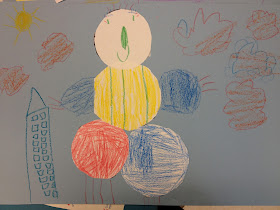I got the idea for this lesson while browsing through the art teacher tag on Instagram. When I see an idea I want to use, I take a screenshot and save it for later. This is the first one that I have I put to use!
This lesson does require some prep, unless you honestly expect kindergartners to be able to use a ruler properly. I used scrap paper from another project. I had cut four inches off of paper for another grade and was left with these 4x12 inch slices of paper. On the short sides of the paper, I picked a width and marked it with lines that would later be connected by my students. This is important so all of the lines will fit next to one another and form one, larger line.
I used a method I learned in printmaking class to mark the papers more quickly.
I started the lesson by asking the students to give me a definition of a line. This discussion guided the class to talking about different types of line. I had a half sheet of computer paper that I put each type of line on, i.e. zig-zag, curvy, wavy, thick, thin, etc.
I then demonstrated the project for the students while they watched around my table.
- With a black crayon, connect the top dashes with a crazy line.
- With a black crayon, connect the bottom dashes with a crazy line.
- Color inside the black lines (the middle) with a black crayon.
- Use all the other colors on the top and bottom! Make it random, not a "picture."
I demonstrated ALL of the steps for the students until it was through, emphasizing that they needed to color neatly, only use black on the line, etc.
I had students go back to their seats and passed out the papers with the front side down. I instructed students to write their names on the side I put down for them. I then vocally walked the students through all of the steps again. It may be necessary to walk around the room and help some with the line part. A lot of students don't want to color between the dashes, connect the dashes, etc.
As the students finished, I had them bring their lines to me at the back table. I put two pieces of masking tape on the back of their lines, and connected them all on the wall! I wrote the teacher's name on the inside of my line and put it at the very end. The students loved pointing out where their lines were. I'd say it was a pretty successful project.





















































